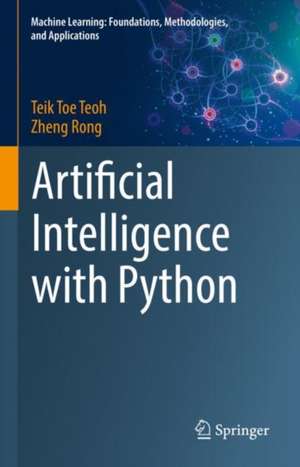Artificial Intelligence with Python: Machine Learning: Foundations, Methodologies, and Applications
Autor Teik Toe Teoh, Zheng Rongen Limba Engleză Hardback – 17 mar 2022
This book introduces readers to various topics and examples of programming in Python, as well as key concepts in artificial intelligence. Python programming skills will be imparted as we go along. Concepts and code snippets will be covered in a step-by-step manner, to guide and instill confidence in beginners. Complex subjectsin deep learning and machine learning will be broken down into easy-to-digest content and examples. Artificial intelligence implementations will also be shared, allowing beginners to generate their own artificial intelligence algorithms for reinforcement learning, style transfer, chatbots, speech, and natural language processing.
| Toate formatele și edițiile | Preț | Express |
|---|---|---|
| Paperback (1) | 305.72 lei 3-5 săpt. | +22.64 lei 4-10 zile |
| Springer Nature Singapore – 18 mar 2023 | 305.72 lei 3-5 săpt. | +22.64 lei 4-10 zile |
| Hardback (1) | 373.37 lei 3-5 săpt. | +29.11 lei 4-10 zile |
| Springer Nature Singapore – 17 mar 2022 | 373.37 lei 3-5 săpt. | +29.11 lei 4-10 zile |
Preț: 373.37 lei
Preț vechi: 466.71 lei
-20% Nou
Puncte Express: 560
Preț estimativ în valută:
71.45€ • 74.32$ • 58.99£
71.45€ • 74.32$ • 58.99£
Carte disponibilă
Livrare economică 25 martie-08 aprilie
Livrare express 08-14 martie pentru 39.10 lei
Preluare comenzi: 021 569.72.76
Specificații
ISBN-13: 9789811686146
ISBN-10: 9811686149
Pagini: 336
Ilustrații: XIV, 336 p. 20 illus. in color.
Dimensiuni: 155 x 235 x 28 mm
Greutate: 0.67 kg
Ediția:1st ed. 2022
Editura: Springer Nature Singapore
Colecția Springer
Seria Machine Learning: Foundations, Methodologies, and Applications
Locul publicării:Singapore, Singapore
ISBN-10: 9811686149
Pagini: 336
Ilustrații: XIV, 336 p. 20 illus. in color.
Dimensiuni: 155 x 235 x 28 mm
Greutate: 0.67 kg
Ediția:1st ed. 2022
Editura: Springer Nature Singapore
Colecția Springer
Seria Machine Learning: Foundations, Methodologies, and Applications
Locul publicării:Singapore, Singapore
Cuprins
Part I Python.- 1 About Python.- 2 What’s Python?.- 3 An Introductory Example.- 4 Basic Python.- 5 Intermediate Python.- 6 Advanced Python.- 7 Python for data analysis.- Part II Artificial Intelligence Basics.- 8 Introduction to artificial intelligence.- 9 Data wrangling.- 10 Regression.- 11 Classification.- 12 Clustering.- 13 Association Rules.- Part III Artificial Intelligence.- Implementations.- 14 Text Mining.- 15 Image Processing.- 16 Convolutional Neural Networks.- 17 Chatbot, Speech and NLP.- 18 Deep Convolutional Generative Adversarial Network.- 19 Neural style transfer.- 20 Reinforcement learning.- 21 References.
Notă biografică
Dr. Teoh has been pursuing research in big data, deep learning, cybersecurity, artificial intelligence, machine learning, and software development for more than 25 years. His works have been published in more than 50 journals, conference proceedings, books, and book chapters. His qualifications include a PhD in computer engineering from the NTU, Doctor of Business Administration from the University of Newcastle, Master of Law from the NUS, LLB and LLM from the UoL, CFA, ACCA, and CIMA. He has more than 15 years’ experience in data mining, quantitative analysis, data statistics, finance, accounting, and law and is passionate about the synergy between business and technology.
Zheng Rong is a software engineer with 4 years of experience. He embraces the ambiguity of data and enjoys the challenges presented by business problems. He has 3 years of teaching experience in data mining and data science, and has coauthored three journal publications on machine learning and deeplearning. He is interested in making learning programming and technology easy for all, including those from a non-technical background.
Zheng Rong is a software engineer with 4 years of experience. He embraces the ambiguity of data and enjoys the challenges presented by business problems. He has 3 years of teaching experience in data mining and data science, and has coauthored three journal publications on machine learning and deeplearning. He is interested in making learning programming and technology easy for all, including those from a non-technical background.
Textul de pe ultima copertă
Entering the field of artificial intelligence and data science can seem daunting to beginners with little to no prior background, especially those with no programming experience. The concepts used in self-driving cars and virtual assistants like Amazon’s Alexa may seem very complex and difficult to grasp. The aim of Artificial Intelligence in Python is to make AI accessible and easy to understand for people with little to no programming experience though practical exercises. Newcomers will gain the necessary knowledge on how to create such systems, which are capable of executing tasks that require some form of human-like intelligence.
This book introduces readers to various topics and examples of programming in Python, as well as key concepts in artificial intelligence. Python programming skills will be imparted as we go along. Concepts and code snippets will be covered in a step-by-step manner, to guide and instill confidence in beginners. Complex subjectsin deep learning and machine learning will be broken down into easy-to-digest content and examples. Artificial intelligence implementations will also be shared, allowing beginners to generate their own artificial intelligence algorithms for reinforcement learning, style transfer, chatbots, speech, and natural language processing.
This book introduces readers to various topics and examples of programming in Python, as well as key concepts in artificial intelligence. Python programming skills will be imparted as we go along. Concepts and code snippets will be covered in a step-by-step manner, to guide and instill confidence in beginners. Complex subjectsin deep learning and machine learning will be broken down into easy-to-digest content and examples. Artificial intelligence implementations will also be shared, allowing beginners to generate their own artificial intelligence algorithms for reinforcement learning, style transfer, chatbots, speech, and natural language processing.
Caracteristici
An essential artificial intelligence tutorial for people with little to no programming experience Easy-to-digest content and code snippets covered in a step-by-step manner Instructs how to implement your own artificial intelligence algorithms











